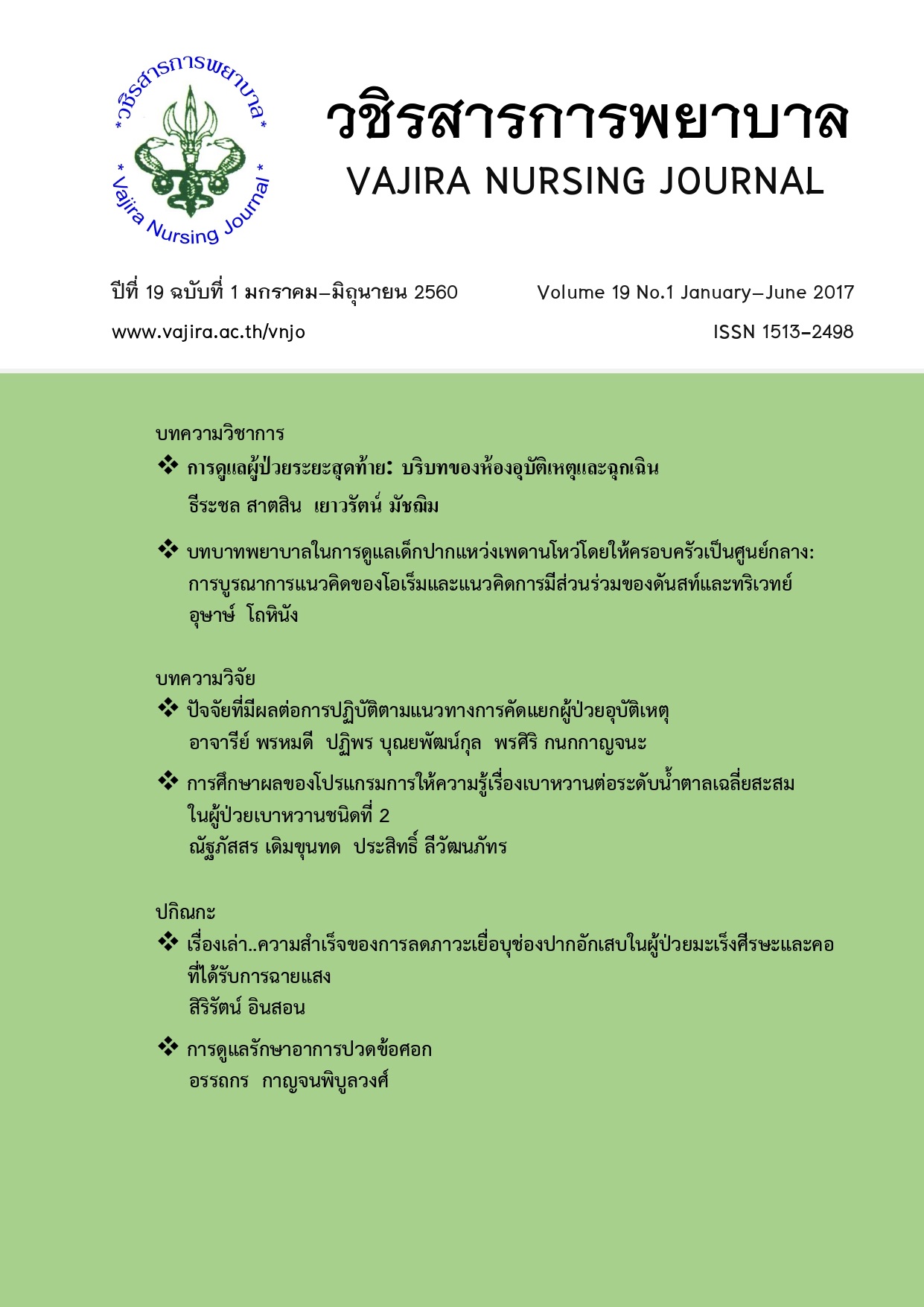บทบาทพยาบาลในการดูแลเด็กปากแหว่งเพดานโหว่โดยให้ครอบครัวเป็นศูนย์กลาง: การบูรณาการแนวคิดของโอเร็มและแนวคิดการมีส่วนร่วมของดันสท์และทริเวทย์
Main Article Content
บทคัดย่อ
เด็กปากแหว่งเพดานโหว่มีการเจริญเติบโตและพัฒนาการช้ากว่าเด็กปกติ เนื่องจากได้รับสารอาหารไม่เพียงพอ จากความลำบากในการดูด เคี้ยวและกลืน หรืออาจมีสำลักนม อาหาร ทำให้เกิดการติดเชื้อใน หูชั้นกลางเรื้อรัง มีปัญหาในการได้ยิน ส่งผลกระทบต่อการสื่อสารและมีปมด้อยในการเข้าสังคม การดูแล อย่างใกล้ชิดของครอบครัวเพื่อทำการประเมินและตอบสนองต่อความต้องการตามระยะพัฒนาการและภาวะเบี่ยงเบนทางด้านสุขภาพมีความจำเป็น ระบบการพยาบาลที่สนับสนุนและส่งเสริมครอบครัวให้สามารถดูแลบุคคลในภาวะพึ่งพาตามแนวคิดของโอเร็ม และการมีส่วนร่วมของครอบครัวในการดูแลสมาชิกในครอบครัวตามแนวคิดของดันสท์และทริเวทย์ จึงมีความสำคัญต่อการสนับสนุนครอบครัวให้สามารถดูแลเด็กปากแหว่งเพดานโหว่ได้ถูกต้องและเหมาะสม
Article Details
เนื้อหาและข้อมูลในบทความที่ลงตีพิมพ์ในวชิรสารการพยาบาลถือเป็นข้อคิดเห็นและความรับผิดชอบของผู้เขียนบทความโดยตรง ซึ่งกองบรรณาธิการไม่จำเป็นต้องเห็นด้วย หรือร่วมรับผิดชอบใด ๆ ทั้งสิ้น
บทความ ข้อมูล เนื้อหา รูปภาพ ฯลฯ ที่ได้รับการตีพิมพ์ในวชิรสารการพยาบาล ถือเป็นลิขสิทธิ์ของวชิรสารการพยาบาล หากบุคคลใดหรือหน่วยงานใดต้องการนำทั้งหมดหรือส่วนหนึ่งส่วนใดไปเผยแพร่ต่อหรือเพื่อกระทำการใด ๆ จะต้องได้รับอนุญาตเป็นลายลักอักษรจากวชิรสารการพยาบาลก่อนเท่านั้น
เอกสารอ้างอิง
กิตติลักษณ์ จุลลัษเฐียร. (2560). ปัญหาจากภาวะปากแหว่งเพดานโหว่. [cited 2017 March 12]. Available from baby.haijai.com/.
จันทร์เพ็ญ สันตวาจา อภิญญา เพียรพิจารณ์ รัตนาภรณ์ ศิริวัฒน์ชัยพร. (2548). แนวคิดพื้นฐานทฤษฎีและกระบวนการ พยาบาล. พิมพ์ครั้งที่ 1นนทบุรี: โรงพิมพ์พิมพลักษณ์.
ฉันทิกา จันทร์ ยุวดี พงษ์สาระนันทกุล. (2558). การเจริญเติบโตและพัฒนาการ: การพยาบาลเด็กเล่ม 1 คณะพยาบาลศาสตร์ มหาวิทยาลัยมหิดล.(หน้า 1-61). พิมพ์ครั้งที่ 3. กรุงเทพฯ: พรี-วัน.
ทัศนี ประสบกิตติคุณ. (2558). แนวคิดที่สำคัญในการพยาบาลผู้ป่วยเด็ก: การพยาบาลเด็กคณะพยาบาลศาสตร์มหาวิทยาลัยมหิดล. พิมพ์ครั้งที่ 3. กรุงเทพฯ: พรี-วัน.
ทัศนีย์ อรรถารส. (2555). มโนทัศน์การพยาบาลเด็ก: การพยาบาลเด็กวิทยาลัยพยาบาลสภากาชาดไทย. พิมพ์ครั้งที่ 3. กรุงเทพฯ: โรงพิมพ์แห่งจุฬาลงกรณ์มหาวิทยาลัย.
นงลักษณ์ จินตนาดิลก. (2558). เด็กที่เข้ารับการรักษาในโรงพยาบาล: การพยาบาลเด็กคณะพยาบาลศาสตร์มหาวิทยาลัยมหิดล. (หน้า 237-249). พิมพ์ครั้งที่ 3. กรุงเทพฯ: พรี-วัน.
เบญจมาศ พระธานี. (2557). ปากแหว่งเพดานโหว่: ปัญหาทางการพูดและการรักษาแบบสหสาขาวิชาชีพ. (หน้า3-26). ขอนแก่น: โรงพิมพ์มหาวิทยาลัยขอนแก่น.
เบญจมาศ พระธานี. (2559). ปากแหว่งเพดานโหว่. [cited 2017 March 12]. Available from http://haamor.com/th.
บวรศิลป์ เชาวน์ชื่น เบญจมาศ พระธานี สุธีรา ประดับวงษ์. (2554). คู่มือผู้ปกครอง แนวทางการดูแลรักษา ผู้ที่มีภาวะปากแหว่งเพดานโหว่. ขอนแก่น: โรงพิมพ์คลังนานาวิทยา.
สุดารัตน์ สุวรรณเทวะคุปต์. (2558). การพยาบาลเด็กก่อนและหลังผ่าตัด: การพยาบาลเด็กคณะพยาบาลศาสตร์มหาวิทยาลัยมหิดล. (หน้า 237-249). พิมพ์ครั้งที่ 3. กรุงเทพฯ: พรี-วัน.
สมจิต หนุเจริญกุล. (2543). การส่งเสริมสุขภาพ: แนวคิด ทฤษฎีและการปฏิบัติการพยาบาล.นครศรีธรรมราช: มหาวิทยาลัยวลัยลักษณ์.
อรุณศรี บุณนาค. (2558). การสร้างเสริมโภชนาการในเด็ก: การพยาบาลเด็กคณะพยาบาลศาสตร์มหาวิทยาลัยมหิดล. (หน้า 63-73). พิมพ์ครั้งที่ 3. กรุงเทพฯ: พรี-วัน.
Dusnt CJ.,Trivett CM. (1996). Empowerment, effective help giving practices and family-centered care. Peddiaices Nurse. 22(4): 334-337
Hockenberry M.J., Wilson D. (2015). Wong’s nursing Care of Infants and Children. 10thed. St. Louis: Mosby.
Hormnaim N. (2014). The Nursing Roles to Promote Wound Healing by Using Nutrition Principles. Journal of the police nurse, 6 (2): 236-249.
Mossey P., Little J., Munger R., Dixon M., Shaw W. (2009). Cleft lip and palate. Lancet, 374: 1773-85.
Noipong S., Prasopkittikun T., Nookong A. (2012). The effects of an empowerment program on self-efficacy in child care and satisfaction towards nursing service in mothers shoes children are undergoing orthopaedic surgery. Journal of nursing science, 30(3):36-45.
Orem D.E. (2010). Nursing concepts of practice. (6thed.). St Louis: Mosby.
Pathumwiwatana P., Tongsukho S., Naratippakorn T., Praduwong S., Chusilp K. (2010). The promotion of exclusive brestfeeding in infant with complete cleft and palate during the first 6 months after child birth at srinagarind hospital. J Med Assoc Thai, 93Suppl.4:S71-77.
Prathanee B. (2002). Cleft lip-palate and craniofacial anomalies. 2nded. (p271-314). Khon Kaen: Siriphan Offset Publisher.
Prathanee B., Thanawiratananit P., Thanawiratananit S.. (2013). Speech, Language, Voice, Resonance and Hearing Disorders in Patients with Cleft Lip and Palate. J Med Assoc Thai, 95 Suppl.11:S71-80.
Prathanee B. & Thohinung U. (2016). Caregivers’ role in caring for child with Cleft Lip /Palate. J Med Assoc Thai, 99 Suppl.5:S21-27.
Puthilukul P. (2015). Caring Cleft Lip /Palate (CLP). [cited 2015 July 25]. Available from http://www.healthcarethai.com4.
Shelton T., Terri L., Stepanek S., Jennifer S. (1994). Family-Centered Care for Children Needing Specialized Health and Developmental Services. 3thed. Bethesda, MD: Association for the Care of Children's Health.


